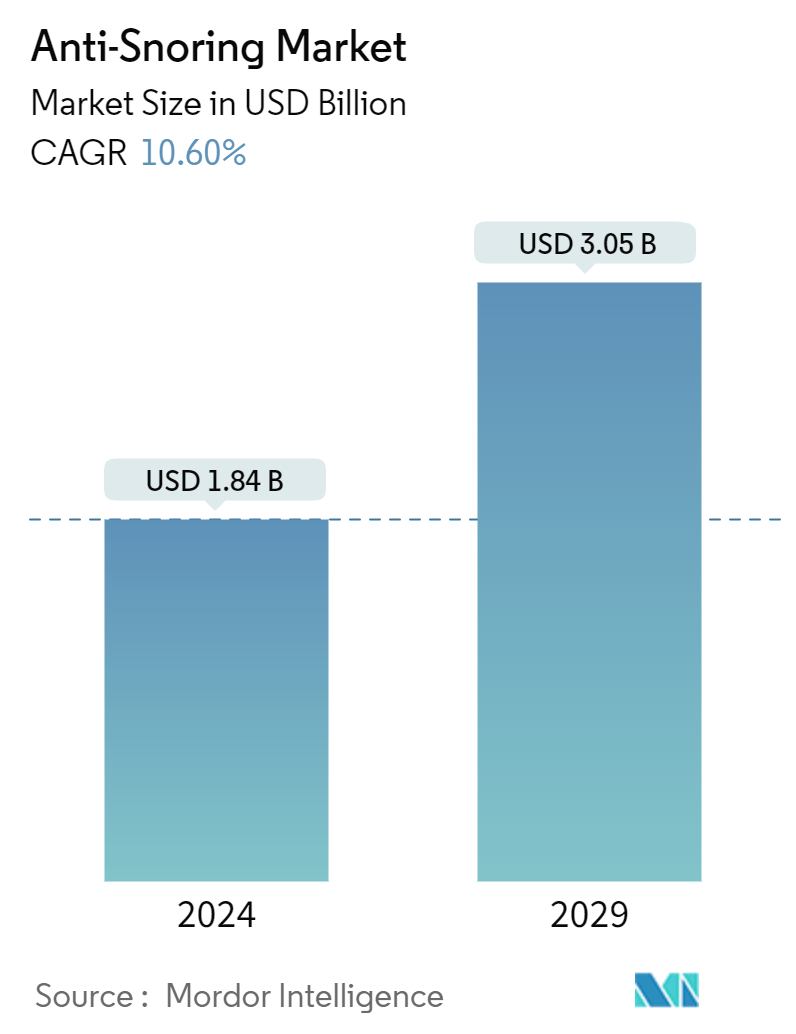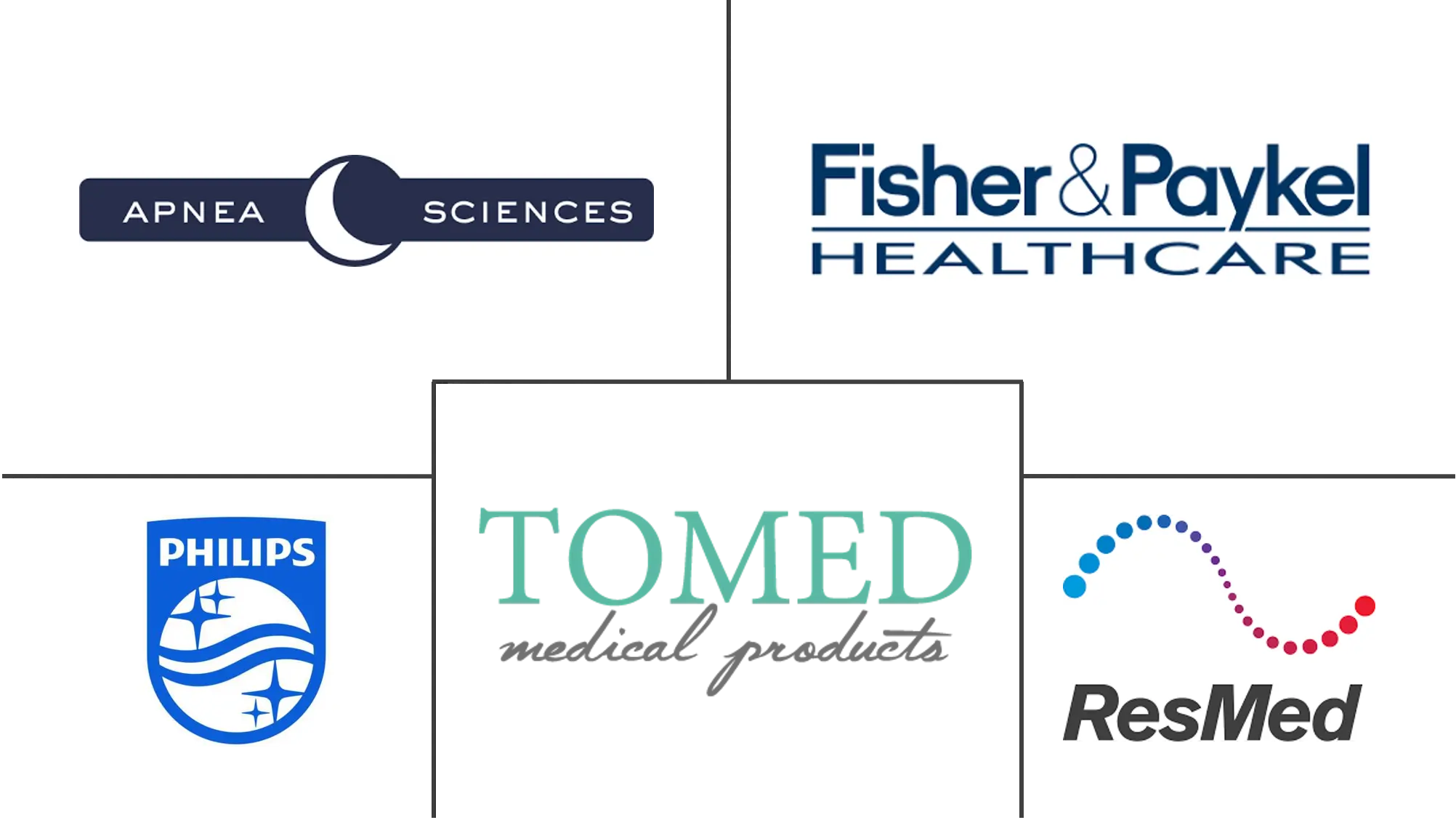Market Size of Anti-Snoring Industry

| Study Period | 2019 - 2029 |
| Market Size (2024) | USD 1.84 Billion |
| Market Size (2029) | USD 3.05 Billion |
| CAGR (2024 - 2029) | 10.60 % |
| Fastest Growing Market | Asia Pacific |
| Largest Market | North America |
| Market Concentration | Low |
Major Players
*Disclaimer: Major Players sorted in no particular order |
Anti-Snoring Devices Market Analysis
The Anti-Snoring Market size is estimated at USD 1.84 billion in 2024, and is expected to reach USD 3.05 billion by 2029, growing at a CAGR of 10.60% during the forecast period (2024-2029).
An increase in the obese and geriatric population, increasing smoking and alcohol consumption, technological advancements in anti-snoring devices, and increased awareness among the people are the key factors responsible for the growth of the market.
Obesity, driven by sedentary lifestyles and poor dietary choices, is a primary catalyst for market expansion. For instance, the 2024 World Obesity Atlas report forecasts that around 79% of adults identified as overweight or obese will be in low-to-middle-income countries by 2035. The global count of obese adults, at 0.81 billion in 2020, is set to double to 1.53 billion by 2035. Additionally, the report highlights that 88% of children categorized as overweight or obese will likely be in low-to-middle-income nations by 2035. This rising obesity rate is leading to more snoring incidents, as fat accumulation in the neck can obstruct the upper airway during sleep, boosting the demand for snoring devices.
Tonsillectomy, a surgical procedure, is known to alleviate snoring, especially in children, often within a month post-surgery. For instance, an August 2022 update from Statpearls highlighted that tonsillectomy ranks among the most frequently conducted surgeries in the United States, with over 500,000 annual cases in children under 15. Sleep-disordered breathing (SDB) is a primary reason for these tonsillectomies. Given this, the high volume of tonsillectomy procedures is likely to drive demand for anti-snoring solutions, like tongue-retaining devices, bolstering market growth.
Technological innovations and product launches by key players are set to further fuel market expansion. For instance, in January 2023, Vivos Therapeutics Inc. secured Food and Drug Administration (FDA) clearance for its DNA appliance, targeting mild-to-moderate obstructive sleep apnea (OSA) and snoring.
Similarly, ProSomnus got FDA 510(k) clearance in November 2022 for its ProSomnus EVO [PH] device. This precision oral appliance therapy (OAT) aims to mitigate nighttime snoring and mild to moderate OSA in adults by stabilizing the jaw during sleep, enhancing pharyngeal space, and minimizing upper airway collapse risks.
Given the rising obesity rates, sleep disorders, and frequent product approvals, the market is poised for growth. Yet, challenges like the steep price of custom oral devices and societal stigma surrounding snoring could temper this expansion.
Anti-Snoring Devices Industry Segmentation
Anti-snoring treatment devices are tools designed to curb snoring. Typically, these devices come in two pieces, fitting over the upper and lower teeth. By shifting the lower jaw forward, they expand the airway, facilitating easier breathing, diminishing snoring, and mitigating the risks and severity of obstructive sleep apnea.
The anti-snoring treatment market is segmented by device type, surgical procedure, and geography. By device type, the market is segmented into mandibular advancement devices (MAD), tongue stabilizing devices (TSD), continuous positive airway pressure (CPAP) devices, and other device types. By surgical procedure, the market is segmented into uvulopalatopharyngoplasty (UPPP), somnoplasty, pillar procedure, tonsillectomy, radiofrequency palatoplasty, and other surgical procedures. By geography, the market is divided into North America, Europe, Asia-Pacific, and Rest of the World. The report offers the value (in USD) for the above segments.
| By Device Type | |
| Mandibular Advancement Devices (MAD) | |
| Tongue Stabilizing Devices (TSD) | |
| Continuous Positive Airway Pressure (CPAP) Devices | |
| Other Device Types |
| By Surgical Procedure | |
| Uvulopalatopharyngoplasty (UPPP) | |
| Somnoplasty | |
| Pillar Procedure | |
| Tonsillectomy | |
| Radiofrequency Palatoplasty | |
| Other Surgical Procedures |
| Geography | ||||||||
| ||||||||
| ||||||||
| ||||||||
| ||||||||
|
Anti-Snoring Market Size Summary
The anti-snoring devices market is poised for significant growth, driven by factors such as the increasing prevalence of obesity, a growing geriatric population, and heightened awareness of sleep disorders. Technological advancements and new product launches are further propelling market expansion. The demand for devices like CPAP machines has surged, particularly during the COVID-19 pandemic, due to their effectiveness in managing sleep-disordered breathing, which was linked to higher hospitalization rates among infected individuals. The market is also benefiting from the high incidence of obstructive sleep apnea, which necessitates the use of such devices. However, challenges such as the high cost of custom-made oral devices and the social stigma associated with snoring may hinder market growth.
North America is expected to dominate the anti-snoring devices market, supported by substantial research and development investments, a high concentration of market players, and a significant prevalence of sleep disorders. The region's market growth is further bolstered by numerous product launches and regulatory approvals, such as the introduction of innovative devices like the DreamStation 2 CPAP and AirSense 11. The competitive landscape is fragmented, with key players like Fisher & Paykel Healthcare Limited, Koninklijke Philips NV, and ResMed holding significant market shares. These companies are actively developing and launching new products to meet the rising demand, particularly in regions with a high burden of sleep disorders.
Anti-Snoring Market Size - Table of Contents
-
1. MARKET DYNAMICS
-
1.1 Market Overview
-
1.2 Market Drivers
-
1.2.1 Increase in Obesity and Geriatric Population
-
1.2.2 Increasing Smoking and Alcohol Consumption
-
1.2.3 Technological Advancements in Anti-Snoring Devices
-
-
1.3 Market Restraints
-
1.3.1 High Costs of Custom-made Oral Devices
-
1.3.2 Poor Efficacy and Lack of Scientific Validation of the Anti-snoring Devices
-
1.3.3 Social Stigma Associated with Snoring
-
-
1.4 Porter's Five Forces Analysis
-
1.4.1 Threat of New Entrants
-
1.4.2 Bargaining Power of Buyers/Consumers
-
1.4.3 Bargaining Power of Suppliers
-
1.4.4 Threat of Substitute Products
-
1.4.5 Intensity of Competitive Rivalry
-
-
-
2. MARKET SEGMENTATION (Market Size by Value - USD)
-
2.1 By Device Type
-
2.1.1 Mandibular Advancement Devices (MAD)
-
2.1.2 Tongue Stabilizing Devices (TSD)
-
2.1.3 Continuous Positive Airway Pressure (CPAP) Devices
-
2.1.4 Other Device Types
-
-
2.2 By Surgical Procedure
-
2.2.1 Uvulopalatopharyngoplasty (UPPP)
-
2.2.2 Somnoplasty
-
2.2.3 Pillar Procedure
-
2.2.4 Tonsillectomy
-
2.2.5 Radiofrequency Palatoplasty
-
2.2.6 Other Surgical Procedures
-
-
2.3 Geography
-
2.3.1 North America
-
2.3.1.1 United States
-
2.3.1.2 Canada
-
2.3.1.3 Mexico
-
-
2.3.2 Europe
-
2.3.2.1 Germany
-
2.3.2.2 United Kingdom
-
2.3.2.3 France
-
2.3.2.4 Italy
-
2.3.2.5 Spain
-
2.3.2.6 Rest of Europe
-
-
2.3.3 Asia-Pacific
-
2.3.3.1 China
-
2.3.3.2 Japan
-
2.3.3.3 India
-
2.3.3.4 Australia
-
2.3.3.5 South Korea
-
2.3.3.6 Rest of Asia-Pacific
-
-
2.3.4 Middle East and Africa
-
2.3.4.1 GCC
-
2.3.4.2 South Africa
-
2.3.4.3 Rest of Middle East and Africa
-
-
2.3.5 South America
-
2.3.5.1 Brazil
-
2.3.5.2 Argentina
-
2.3.5.3 Rest of South America
-
-
-
Anti-Snoring Market Size FAQs
How big is the Anti-Snoring Market?
The Anti-Snoring Market size is expected to reach USD 1.84 billion in 2024 and grow at a CAGR of 10.60% to reach USD 3.05 billion by 2029.
What is the current Anti-Snoring Market size?
In 2024, the Anti-Snoring Market size is expected to reach USD 1.84 billion.

